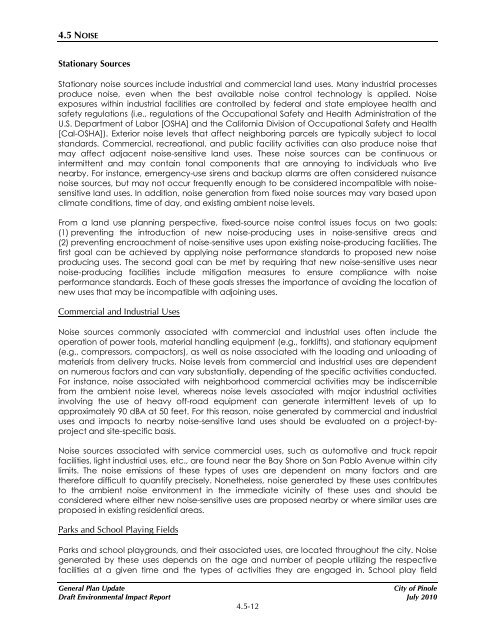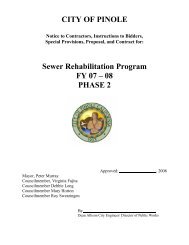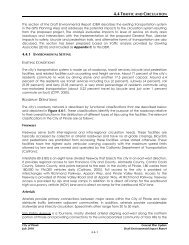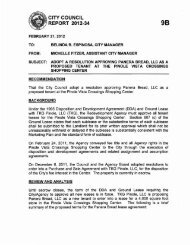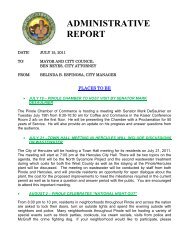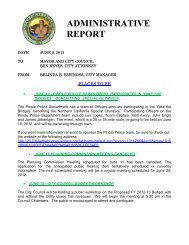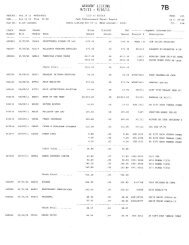4.5 NOISE - City of Pinole
4.5 NOISE - City of Pinole
4.5 NOISE - City of Pinole
Create successful ePaper yourself
Turn your PDF publications into a flip-book with our unique Google optimized e-Paper software.
<strong>4.5</strong> <strong>NOISE</strong><br />
Stationary Sources<br />
Stationary noise sources include industrial and commercial land uses. Many industrial processes<br />
produce noise, even when the best available noise control technology is applied. Noise<br />
exposures within industrial facilities are controlled by federal and state employee health and<br />
safety regulations (i.e., regulations <strong>of</strong> the Occupational Safety and Health Administration <strong>of</strong> the<br />
U.S. Department <strong>of</strong> Labor [OSHA] and the California Division <strong>of</strong> Occupational Safety and Health<br />
[Cal-OSHA]). Exterior noise levels that affect neighboring parcels are typically subject to local<br />
standards. Commercial, recreational, and public facility activities can also produce noise that<br />
may affect adjacent noise-sensitive land uses. These noise sources can be continuous or<br />
intermittent and may contain tonal components that are annoying to individuals who live<br />
nearby. For instance, emergency-use sirens and backup alarms are <strong>of</strong>ten considered nuisance<br />
noise sources, but may not occur frequently enough to be considered incompatible with noisesensitive<br />
land uses. In addition, noise generation from fixed noise sources may vary based upon<br />
climate conditions, time <strong>of</strong> day, and existing ambient noise levels.<br />
From a land use planning perspective, fixed-source noise control issues focus on two goals:<br />
(1) preventing the introduction <strong>of</strong> new noise-producing uses in noise-sensitive areas and<br />
(2) preventing encroachment <strong>of</strong> noise-sensitive uses upon existing noise-producing facilities. The<br />
first goal can be achieved by applying noise performance standards to proposed new noise<br />
producing uses. The second goal can be met by requiring that new noise-sensitive uses near<br />
noise-producing facilities include mitigation measures to ensure compliance with noise<br />
performance standards. Each <strong>of</strong> these goals stresses the importance <strong>of</strong> avoiding the location <strong>of</strong><br />
new uses that may be incompatible with adjoining uses.<br />
Commercial and Industrial Uses<br />
Noise sources commonly associated with commercial and industrial uses <strong>of</strong>ten include the<br />
operation <strong>of</strong> power tools, material handling equipment (e.g., forklifts), and stationary equipment<br />
(e.g., compressors, compactors), as well as noise associated with the loading and unloading <strong>of</strong><br />
materials from delivery trucks. Noise levels from commercial and industrial uses are dependent<br />
on numerous factors and can vary substantially, depending <strong>of</strong> the specific activities conducted.<br />
For instance, noise associated with neighborhood commercial activities may be indiscernible<br />
from the ambient noise level, whereas noise levels associated with major industrial activities<br />
involving the use <strong>of</strong> heavy <strong>of</strong>f-road equipment can generate intermittent levels <strong>of</strong> up to<br />
approximately 90 dBA at 50 feet. For this reason, noise generated by commercial and industrial<br />
uses and impacts to nearby noise-sensitive land uses should be evaluated on a project-byproject<br />
and site-specific basis.<br />
Noise sources associated with service commercial uses, such as automotive and truck repair<br />
facilities, light industrial uses, etc., are found near the Bay Shore on San Pablo Avenue within city<br />
limits. The noise emissions <strong>of</strong> these types <strong>of</strong> uses are dependent on many factors and are<br />
therefore difficult to quantify precisely. Nonetheless, noise generated by these uses contributes<br />
to the ambient noise environment in the immediate vicinity <strong>of</strong> these uses and should be<br />
considered where either new noise-sensitive uses are proposed nearby or where similar uses are<br />
proposed in existing residential areas.<br />
Parks and School Playing Fields<br />
Parks and school playgrounds, and their associated uses, are located throughout the city. Noise<br />
generated by these uses depends on the age and number <strong>of</strong> people utilizing the respective<br />
facilities at a given time and the types <strong>of</strong> activities they are engaged in. School play field<br />
General Plan Update <strong>City</strong> <strong>of</strong> <strong>Pinole</strong><br />
Draft Environmental Impact Report July 2010<br />
<strong>4.5</strong>-12


